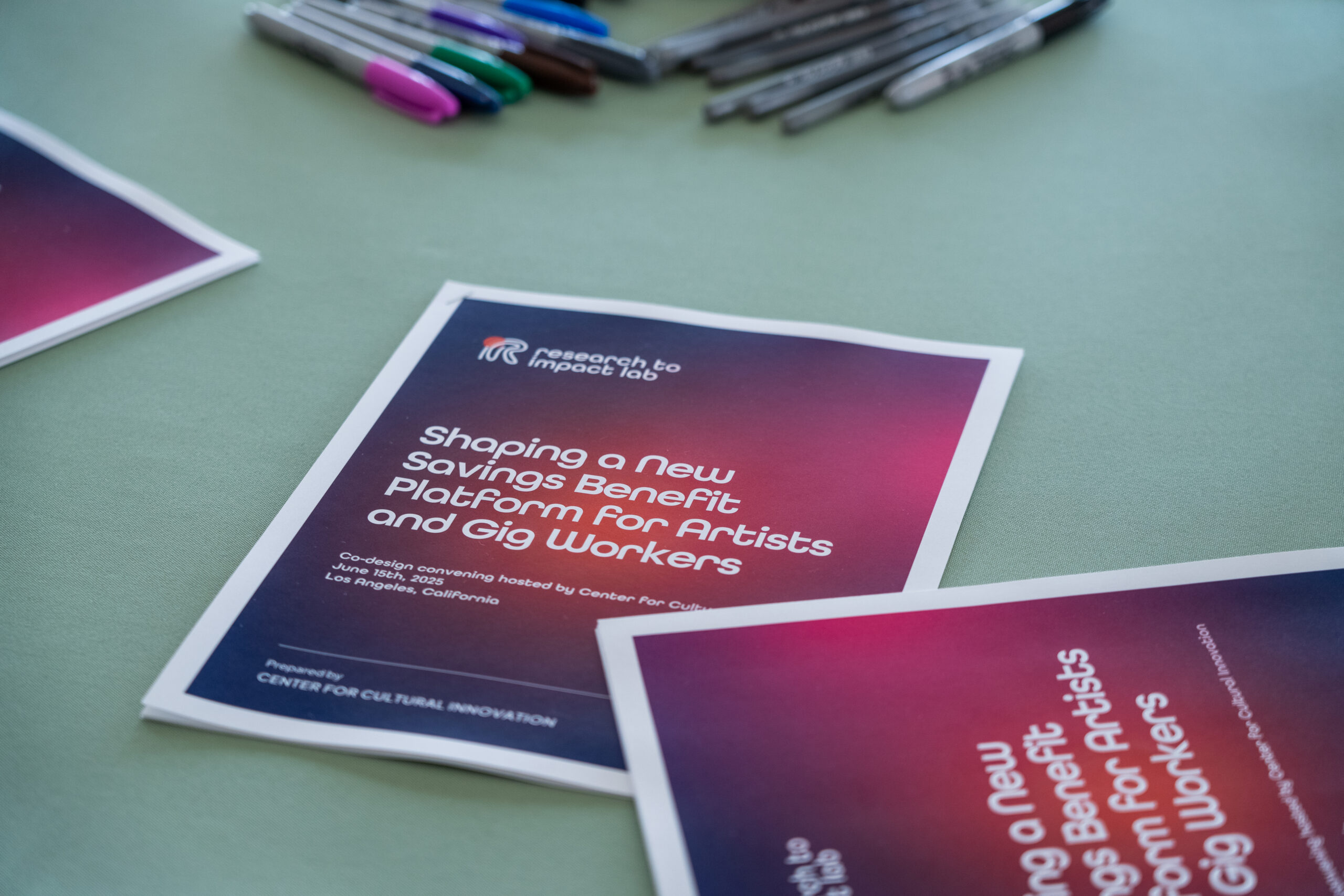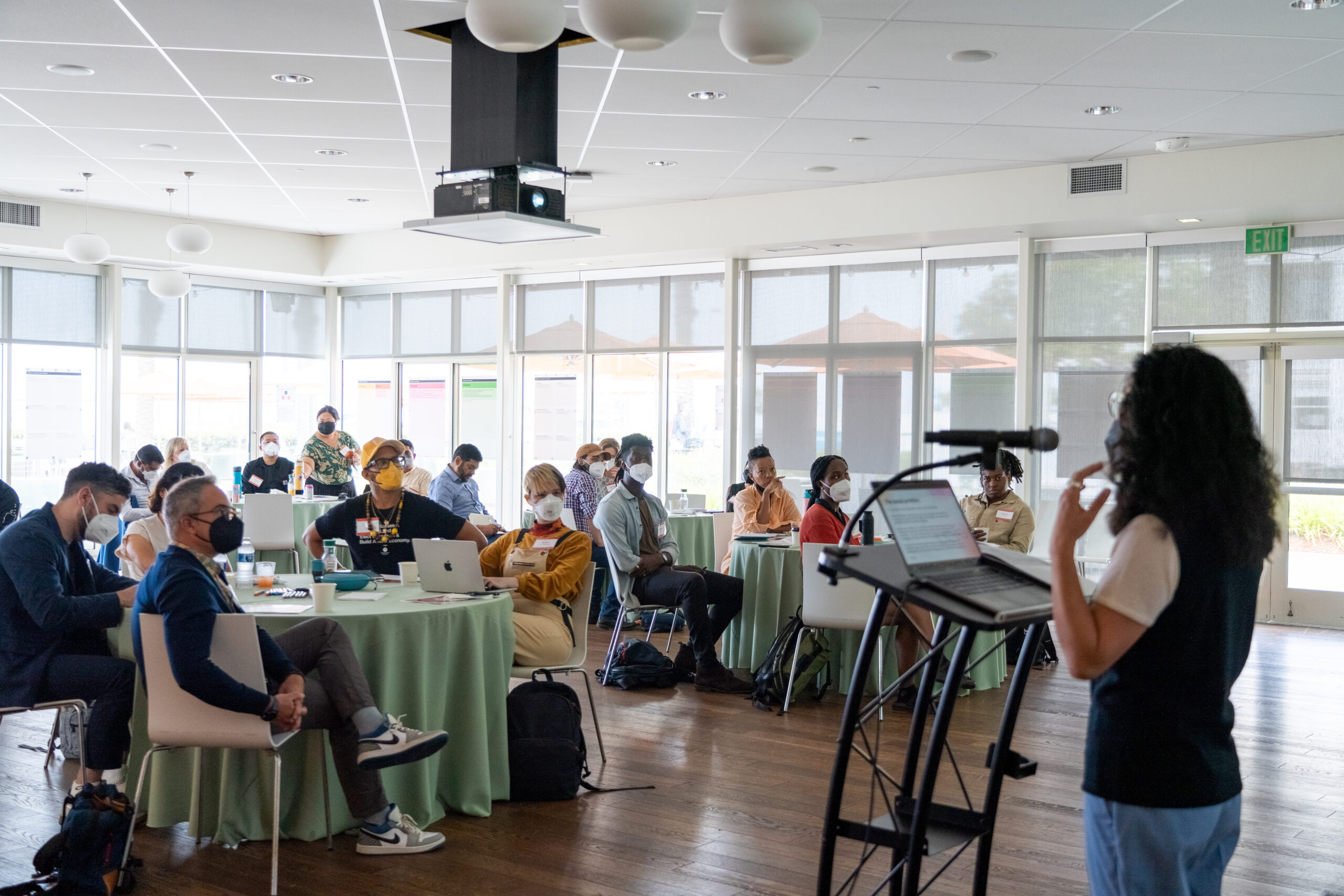Shaping Collective Futures: Co-Designing A New Social Safety Net for Artists and Gig Workers
A behind-the-scenes look at the Cookie Jar Collective convening, where artists, technologists, and policy leaders came together to reimagine savings as a shared resource and explore new models of digital public infrastructure.

Why a Convening?
On July 15, 2025, the Center for Cultural Innovation hosted an in-person co-design convening in Los Angeles, California titled “Shaping a Savings Benefit for Artists and Gig Workers.” The goal of the convening was to bring together a diverse group of stakeholders–including artists, technologists, and policy experts–to engage with an early concept for a technology-enabled system designed for artists and independent workers to pool their savings and collectively decide how and where to spend, loan or invest it. The project is informally called the Cookie Jar Collective.
Our team decided to host the co-design convening because, while we had a semi-clear conception of the tool, we still found ourselves bumping up against many key implementation questions. We had conducted thorough background research, engaged with artists in focus groups, and hosted a technology-focused co-design session at DWeb Camp ‘24, yet we still did not feel confident enough to start writing any code–perhaps because this project has highly ambitious goals.
Our main goals for this system is to help grow the financial security and social cohesion of independent workers. Not only that, but we hope that our system can inspire a shift in the way people relate to money–to see it less as individually-held resources and more as shared resource commons held in communities of trust and governed by mutualistic, cooperative, and solidarity-oriented agreements. The model is based on the concept of Rotating Savings and Credit Associations (ROSCAs, sometimes called tandas or sou-sous) that have been present in communities of color in the U.S. and abroad for generations. We are building on that legacy of mutual aid with the Cookie Jar Collective. Our hope is that we can leverage new technology to scale this idea to a large number of freelancers.
Finally, we aim to demonstrate how U.S. policy makers can use our system to expand benefits for non-traditional (non-W2) workers, a growing share of the workforce who are excluded from a social safety net that only protects those engaged in traditional employment. We realized our ideal roadmap for this system would include it potentially being adopted by a state or local government as a “public option,” similar to state retirement funds like CalSavers that are available to freelancers on an opt-in basis.
These social, cultural, and policy change goals required us to engage early with a broad range of stakeholders, making the participatory model of co-design an ideal design step for this project. This is the Research to Impact Lab’s first incubation project, which means that we are testing different aspects of our technology incubation process and learning along the way. What level of participation is useful? How can we move quickly and keep learning along the way? We’re not a government, though we do intend this product for public good; and we certainly aren’t a tech start up, though we want to be able to innovate swiftly. As a result, we strive for a balance of participation somewhere in between democratic governments building public infrastructure and traditional technology startups building products for profit.
Building digital public infrastructure means not seeking profit but rather seeking positive effects of relationality, participation, social cohesion, diverse opportunities, mutual support and benefit, maintenance, and care.
Our Planning Process
The R2I Lab team engaged in an approximately 9-month process to prepare for and plan the co-design. We began with a selection process for a human-centered design firm partner with whom we would collaborate on the convening design and facilitation. Greater Good Studios (GGS) was ultimately chosen as our partners because of their prior experience working on technology that directly drives state-level policy change.
With GGS’s support, we proceeded with our participant selection process. It was crucial to our team to meet with each prospective invitee individually to connect with them on a personal level, hear about their work, practice explaining our concept directly to them, field any follow-up questions, and gauge their interest in collaborating on the project.
Once we had our twenty-two total participants confirmed, we worked on designing the agenda–again, with the help and guidance of GGS. The whole experience was intentionally designed, including a welcome dinner the night before the convening, in order to create a space for folks to meet and connect across their areas of expertise and interest. On the day, our agenda included three distinct segments: 1) introductions and weaving connections between participants, 2) building a shared understanding of the concept and fielding questions, and 3) collaboratively designing systems with different constraints in small, assigned groups. These segments were cushioned with meals (breakfast and lunch), breaks, and time for conversation and connections.

The Flow of the Agenda on the Day
The event transpired smoothly in that we remained on schedule with plenty of time for each program activity and suitable break time in between.
Each segment on the agenda flowed nicely into the next. Having each participant introduce themselves allowed other folks in the room to build bridges across domains of expertise yet trust in everyone’s values-alignment. Participants expressed the immense value in the diversity of perspectives present in the room including: technology builders from web3 and the decentralized web who recognize the importance of shared governance; leaders of existing tech-enabled mutualistic projects (i.e. Kola Nut Collaborative, Boston Ujima Project, Freelancer’s Union); career policy experts who focus specifically on benefits and safety nets for a changing workforce; Biden administration Department of Justice appointees as well the founding director of CalSavers, a public option retirement savings program; and of course artists who specialize in solidarity practices in their communities, leading cooperatives, collectives, and other mutualistic efforts either utilizing tech or in analog spaces.
In the second segment, we presented the most updated vision of our concept and invited participants to share reflections and ask clarifying questions. We told them, “Take our concept but hold it loosely.” This segment produced a lively Q&A where participants were able to massage the ideas presented, question assumptions based on their own work and experiences, and start to form their own internal vision of what the tool is, how it might work, and where it might be implemented. We were met with many of the same questions we, as a team, have been wrestling with. However, with these key questions in everyone’s mind, we were laying the groundwork for the final exercise–where we formed small groups to answer these questions given different sets of constraints.
Each small group was given one of the following scenarios for the concept: 1) subsidiarity/federated model, 2) platform cooperative, 3) public option, 4) VC-backed app, and 5) DAO/Web 3 version. Using these scenarios, the groups envisioned what the Cookie Jar Collective could look like and answered questions such as: “What is the role of technology?”, “How large are the shared funding pools?”, “What does shared governance look like?”, and more. During the share-outs from this exercise, heard five different manifestations of the concept–each making its own tradeoffs in order to conform to its given structure while accomplishing the project’s goals.

Our Takeaways and an Unexpected Surprise
The convening demonstrated that the problem we are trying to address–the lack of financial security / safety nets for artists and independent contractors–is deeply resonant and there is a hunger for solutions to this problem. Participants felt excited and inspired to be brought together to work with others on designing innovative, more community-driven and collectively-governed solutions to this problem.
- There seemed to be agreement that the solution is complex and therefore requires multi-disciplinary and cross-sectoral collaboration. Many participants expressed the positive value of gathering together in-person and with individuals from such diverse backgrounds and experiences. Many wished the convening could have been longer than just one day because of this complex nature of the system design. In a follow-up form, more than half of participants have expressed interest in continuing involvement in this design process–from technology development, pilot design, user research, partnership development, and more.
- There were elements from each of the 5 scenarios expanded upon at the convening that our team is interested in incorporating into our pilot. Therefore, rather than trying to come to consensus around one singular version of the Cookie Jar Collective, we are working on shaping a list of 2-3 versions around which we can design small pilots with groups of artists from CCI’s core constituency as well as adjacent partner communities.
- As for next steps, we will design and share our pilot program in the next couple of months and conduct outreach to prospective pilot participants and communities–including many of the co-design convening participants and their respective communities. We are also going to be hiring a founder to lead the development of the technology-enabled features of the tool.
- One unexpected surprise was how the success of this convening informed internal conversations within CCI about best practices for building out its relational infrastructure–processes for relationship-formation across multi-disciplinary, cross-sectoral groups to unlock potential future partnerships for our work but also for each participant and their specific projects.
Overall, the convening allowed our team to share the in-progress development of the Cookie Jar Collective concept and receive extremely constructive feedback. We believe that doing so early in the project’s design is essential not only for effective design but also for generating buy-in from the public, private, and civil society sectors. Continuing to build in participatory ways, we believe, will help ensure we don’t repeat past mistakes and that we build something that stands to weather changing economic and political conditions–as good digital public infrastructure should.
We look forward to the next phase of this work!
Read the Co-Design Convening Summary HERE
Read our Concept Brief HERE